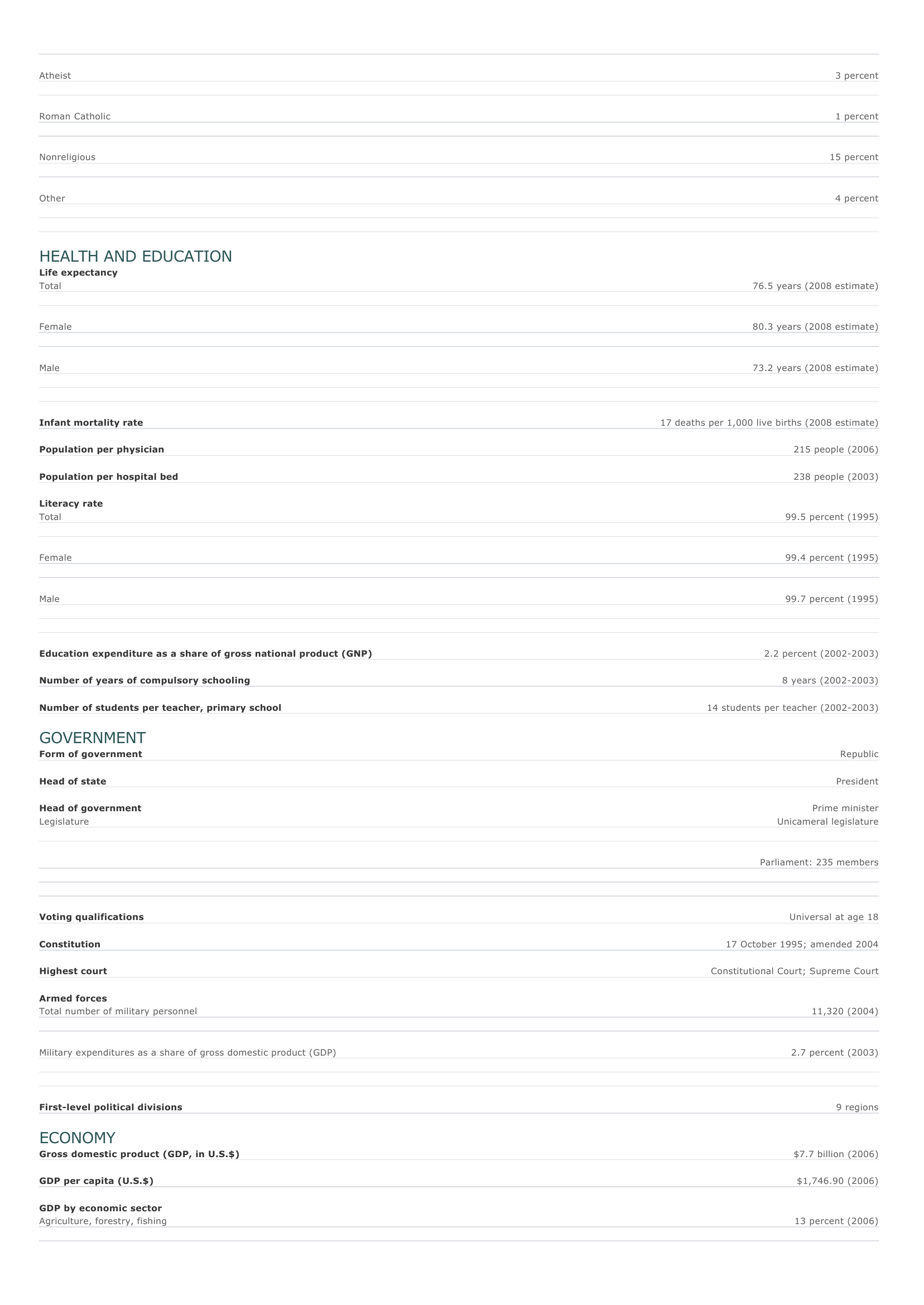
Georgia (country) Facts and Figures. BASIC FACTS Official name Capital Area Georgia Tbilisi 69,700 sq km 26,900 sq mi PEOPLE Population 4,630,841 (2008 estimate) Population growth Population growth rate -0.33 percent (2008 estimate) Projected population in 2025 4,341,061 (2025 estimate) Projected population in 2050 3,784,724 (2050 estimate) Population density 66 persons per sq km (2008 estimate) 172 persons per sq mi (2008 estimate) Urban/rural distribution Share urban 51 percent (2005 estimate) Share rural 49 percent (2005 estimate) Largest cities, with population Tbilisi 1,064,000 (2003 estimate) K'ut'aisi 215,700 (2002 estimate) Rustavi 138,200 (2002 estimate) Bat'umi 124,100 (2002 estimate) Sokhumi Ethnic groups Georgian 112,000 (2002) 70.1 percent A rmenian 8.1 percent Russian 6.3 percent Azeri 5.7 percent Ossetian 3.0 percent A bkhazian 1.8 percent O ther 5.0 percent Languages Georgian (official), Russian, Armenian, Azerbaijani, other Religious affiliations Orthodox Christian 58 percent Muslim 19 percent Atheist 3 percent Roman Catholic 1 percent Nonreligious O ther 15 percent 4 percent HEALTH AND EDUCATION Life expectancy Total 76.5 years (2008 estimate) Female 80.3 years (2008 estimate) Male 73.2 years (2008 estimate) Infant mortality rate 17 deaths per 1,000 live births (2008 estimate) Population per physician 215 people (2006) Population per hospital bed 238 people (2003) Literacy rate Total 99.5 percent (1995) Female 99.4 percent (1995) Male 99.7 percent (1995) Education expenditure as a share of gross national product (GNP) Number of years of compulsory schooling Number of students per teacher, primary school 2.2 percent (2002-2003) 8 years (2002-2003) 14 students per teacher (2002-2003) GOVERNMENT Form of government Head of state Head of government Legislature Republic President Prime minister Unicameral legislature Parliament: 235 members Voting qualifications Constitution Highest court Armed forces Total number of military personnel Military expenditures as a share of gross domestic product (GDP) First-level political divisions Universal at age 18 17 October 1995; amended 2004 Constitutional Court; Supreme Court 11,320 (2004) 2.7 percent (2003) 9 regions ECONOMY Gross domestic product (GDP, in U.S.$) GDP per capita (U.S.$) $7.7 billion (2006) $1,746.90 (2006) GDP by economic sector Agriculture, forestry, fishing 13 percent (2006) I ndustry 24.9 percent (2006) Services 62.1 percent (2006) Employment Number of workers 2,236,809 (2006) Workforce share of economic sector Agriculture, forestry, fishing 54 percent (2005) I ndustry 9 percent (2005) Services 36 percent (2005) Unemployment rate 12.6 percent (2004) National budget (U.S.$) Total revenue $1,741 million (2006) Total expenditure $1,573 million (2006) Monetary unit 1 Georgian lari, consisting of 100 tetri Major trade partners for exports Turkey, Spain, Russia, Italy, and United States Major trade partners for imports Turkey, United States, Azerbaijan, Germany, and Russia ENERGY, COMMUNICATIONS, AND TRANSPORTATION Electricity production Electricity from thermal sources 16.85 percent (2003 estimate) Electricity from hydroelectric sources 83.15 percent (2003 estimate) Electricity from nuclear sources 0 percent (2003 estimate) Electricity from geothermal, solar, and wind sources 0 percent (2003 estimate) Number of radios per 1,000 people 590 (1997) Number of telephones per 1,000 people 151 (2004) Number of televisions per 1,000 people 514 (2000 estimate) Number of Internet hosts per 10,000 people Daily newspaper circulation per 1,000 people Number of motor vehicles per 1,000 people Paved road as a share of total roads 10 (2003) 5 (2000) 63 (2003) 39 percent (2004) SOURCES Basic Facts and People sections Area data are from the statistical bureaus of individual countries. Population, population growth rate, and population projections are from the United States Census Bureau, International Programs Center, International Data Base (IDB) (www.census.gov). Urban and rural population data are from the Food and Agriculture Organization (FAO) of the United Nations (UN), FAOSTAT database (www.fao.org). Largest cities population data and political divisions data are from the statistical bureaus of individual countries. Ethnic divisions and religion data are largely from the latest Central Intelligence Agency (CIA) World Factbook and from various country censuses and reports. Language data are largely from the Ethnologue, Languages of the World, Summer Institute of Linguistics International (www.sil.org). Health and Education section Life expectancy and infant mortality data are from the United States Census Bureau, International Programs Center, International database (IDB) (www.census.gov). Population per physician and population per hospital bed data are from the World Health Organization (WHO) (www.who.int). Education data are from the United Nations Educational, Scientific and Cultural Organization (UNESCO) database (www.unesco.org). Government section Government, independence, legislature, constitution, highest court, and voting qualifications data are largely from various government Web sites, the latest Europa World Yearbook, and the latest Central Intelligence Agency (CIA) World Factbook. The armed forces data is from Military Balance. Economy section Gross domestic product (GDP), GDP per capita, GDP by economic sectors, employment, and national budget data are from the World Bank database (www.worldbank.org). Monetary unit, agriculture, mining, manufacturing, exports, imports, and major trade partner information is from the statistical bureaus of individual countries, latest Europa World Yearbook, and various United Nations and International Monetary Fund (IMF) publications. Energy, Communication, and Transportation section Electricity information is from the Energy Information Administration (EIA) database (www.eia.doe.gov). Radio, telephone, television, and newspaper information is from the United Nations Educational, Scientific and Cultural Organization (UNESCO) database (www.unesco.org). Internet hosts, motor vehicles, and road data are from the World Bank database (www.worldbank.org). Note Figures may not total 100 percent due to rounding. Microsoft ® Encarta ® 2009. © 1993-2008 Microsoft Corporation. All rights reserved.











